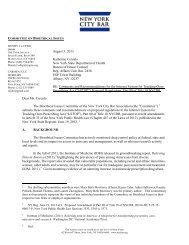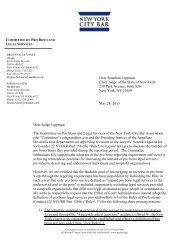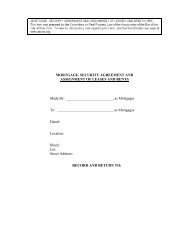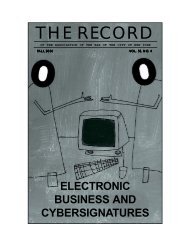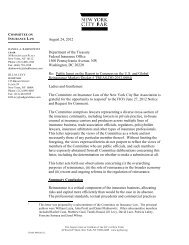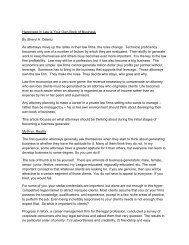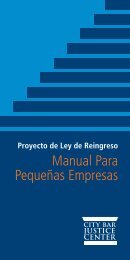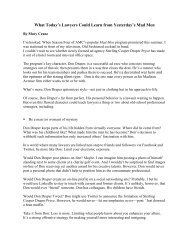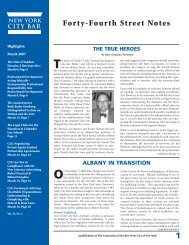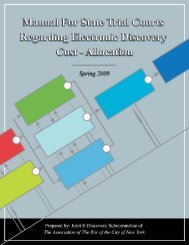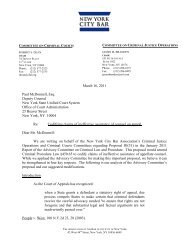2007 Issue 1 - New York City Bar Association
2007 Issue 1 - New York City Bar Association
2007 Issue 1 - New York City Bar Association
You also want an ePaper? Increase the reach of your titles
YUMPU automatically turns print PDFs into web optimized ePapers that Google loves.
I N T E R N A T I O N A L S E C U R I T Y A F F A I R S<br />
pants from Europe, North America, and Asia that apply licensing measures<br />
to the export of specified chemicals, biological agents, and dual-use<br />
chemical and biological manufacturing facilities and equipment. These<br />
export controls are aimed at both curbing proliferation and also “allow[ing]<br />
legitimate trade to prosper in an unfettered manner and promot[ing] peaceful<br />
economic development everywhere.” 122 Since 9/11, the Australia Group has<br />
revised its export restrictions to include items that would be useful to<br />
terrorists rather than states. 123<br />
(2) The Missile Technology Control Regime<br />
Formed in 1987, the MTCR restricts the export of delivery systems<br />
(and related technology) capable of carrying a 500-kilogram payload for<br />
a distance of at least 300 kilometers and systems capable of delivering<br />
weapons of mass destruction. Its group of thirty-three participants largely<br />
overlaps with the countries that make up the Australia Group. 124 The members<br />
agree to a set of guidelines for the export of a list of materials. Some<br />
transfers are prohibited; others are subject to the satisfaction of specific<br />
conditions or the provision of certain assurances. The director of the State<br />
Department’s Office of Chemical, Biological and Missile Nonproliferation<br />
described the value of this regime: “MTCR Partners’ vigorous enforcement<br />
of export controls consistent with the MTCR Guidelines and Annex continues<br />
to make it more difficult for proliferators to get items for their<br />
missile programs, increasing the cost, time, and effort required.” 125<br />
The MTCR is now placing more emphasis on combating the risk of<br />
missile components and components falling into the hands of terrorists.<br />
122. Australian Department of Foreign Affairs & Trade, International Security Affairs Division,<br />
The Australia Group, available at http://www.dfat.gov.au/security/downloads/<br />
australian_group.pdf. Includes a list of participants.<br />
123. See United States General Accounting Office, Strategy Needed to Strengthen Multilateral<br />
Export Control Regimes, Report to Congressional Committees, GAO-03-43, October 2002,<br />
available at http://www.gao.gov/cgi-bin/getrptgao-03-43.<br />
124. List of participants can be found at http://www.state.gov/t/np/rls/prsrl/2002/14497.htm.<br />
125. Van Diepen, supra note 97. The MTCR only addresses the supply side of missile technology.<br />
The United States has also lead the creation of a code of conduct aimed at the demand<br />
side, known as the International Code of Conduct against Ballistic Missile Proliferation (ICOC).<br />
It is a voluntary “political commitment” aimed at preventing states from developing and<br />
stockpiling missile technology. The text may be found at http://projects.sipri.se/expcon/<br />
drafticoc.htm. See also John Bolton, Remarks at the Launching Conference for the International<br />
Code of Conduct Against Ballistic Missile Proliferation, (Nov. 25, 2002), available at<br />
http://www.state.gov/t/us/rm/15488.htm. A critical review of the ICOC is found at http://<br />
www.basicint.org/pubs/Notes/2002international_code.htm.<br />
T H E R E C O R D<br />
56



